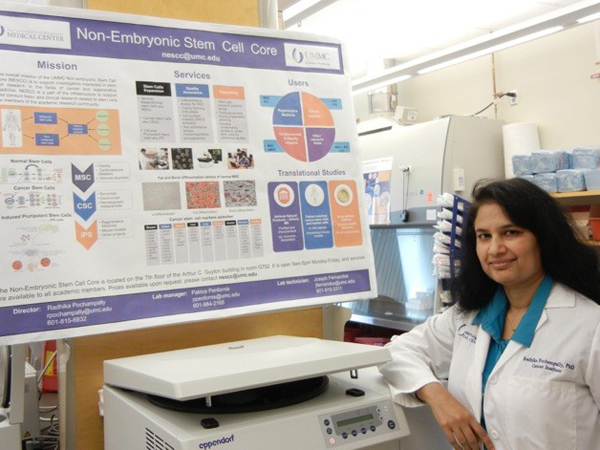New CI lab looks for ‘core’ of disease development

Published in News Stories on December 29, 2014
Researchers at the University of Mississippi Medical Center's Cancer Institute are moving into new arenas with the formation of a Non-Embryonic Stem Cell Core.
Led by cancer researcher Dr. Radhika Pochampally, the core will work with multiple researchers in cancer, heart and other departments to study stem cells and their role in disease and illness.
For cancer studies, the initial focus is on breast and bone cancers, Pochampally said.
“Most of the time, the primary cancer can be treated,” she said. “The cells that survive treatments for primary cancers go into dormancy, and then come back – these are the bad cells, the most difficult to kill.”
Bad? Yes, because those cancer stem cells have the ability to lie low for a long time, roam a person’s body, find a home in another organ and reproduce more malignant cells. Chemotherapy drugs may destroy other tumor cells, but now scientists know that sometimes a few – the cancer stem cells – may remain.
Even more confusing, this scenario doesn’t happen all the time, so researchers want to find out when and why it occurs in some people and not others.
Like a plant, the stem cell roots may lie unseen once the green top is removed or unscathed by pesticides, only to reappear in another season.
Somehow, Pochampally said, these cells have the ability to resist many chemotherapies.
The new core is seeking permission to ask cancer patients for samples of their normal tissue and malignant tissue. Pochampally said if the UMMC Institutional Review Board agrees, her team will use the samples to search for the difference between the normal stem cells and the malignant ones.
On the surface, she said, normal and malignant stem cells from one person may look the same.
“If you go down deeper, they look very different.”
If researchers here can find minuscule differences, then they’ll work with colleagues at the National Center for Natural Products Research at the University of Mississippi in Oxford to find a drug that targets a vulnerable area on the cancer stem cells and leaves normal healthy cells alone.

Vijayakumar
Each person’s cells are different, Pochampally said, so the quest is to find a way to offer personalized medicine.
“The future is personalized medicine,” she said. “The one-size-fits-all type of approach works only about half the time and that is not an acceptable rate of success when it comes to people.”
Dr. Srinivasan Vijayakumar, Cancer Institute director, calls the core a needed addition to the current options for researchers.
“As we learn more about cancer, we need to be able to change to meet the needs of the most recent research,” he said. “This is one of those changes that will help us better search for a cure for cancer.”
Adult stem cells vs embryonic stem cells
Adult stem cells renew themselves by dividing. They can retain their ability to create new cells in many parts of your body.
Think of blood stem cells. They rest in a person’s bone marrow and continuously divide and evolve to create red, white and platelet cells.
Those cells do their job and die, leaving room for more red, white and platelet cells. Cancer stem cells create malignant cells leading to the growth of cancer.
Embryonic stem cells are inside an early embryo and can create more than 200 different types of cells in the human body.
Institutional Review Board
The Medical Center’s Institutional Review Board (IRB), a federally mandated committee of scientists, clinicians, non-scientists and non-affiliated community representatives charged with overseeing all research projects involving human volunteers to protect the rights and welfare of the volunteers, certifying that the research is conducted according to the highest scientific and ethical standards.
Core definition
A core is a laboratory where researchers with multiple interests can go for specific experiments. Cores provide the proper equipment and advice on framing the project to provide the best results.
Cores usually serve many researchers from multiple departments. The Cancer Institute has eight cores and its researchers have access to multiple cores throughout the UMMC and University of Mississippi campuses.


